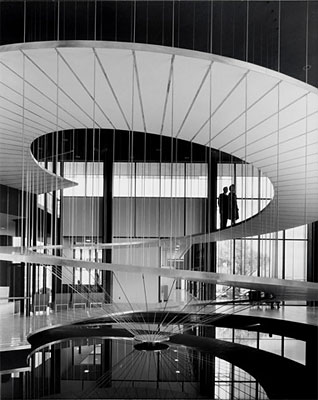| architectural photography
Joe Reifer is looking at getting into large format photography and had this interesting post about Julius Shulman and shooting large format. Julius made his name as an architectural photographer shooting some of the buildings I studied as an architecture student in the early 1960s. While I ended wandering off in different directions, I have retained a love for the architecture of this period. I don't know if I would actually want to live in one of them but they sure look neat! Joe mentions a couple of books by Julius I must get and the photos get me thinking about shooting architectural black and white. I bounce back and forth on whether black and white or color. Enough to feel like a ping pong ball in a Chinese table tennis tournament.
Going big III: Julius, and conceptualization
|
The December 4th issue of the New Yorker features a short piece about Philip Johnsonís Glass House, which was recently photographed by architectural photographer Julius Shulman. Julius Shulman is 96 years old, and last photographed this house in 1963.
If you donít know his name, you probably know his images. Shulman is famous for his photographs of modern architecture by Richard Neutra, Frank Lloyd Wright, and Charles and Ray Eames. Last year I saw a wonderful exhibit of Shulmanís work at the Getty Museum, and also checked out his book, Julius Shulman: Architecture and Its Photography and A Constructed View: The Architectural Photography of Julius Shulman.
Shulman spent two days photographing the Glass House in Chicago. He made sixteen images. Letís have a moment of silence for all the 35mm shooters to gasp. 2 days, 16 images. Probably with a 4◊5 camera and black and white film.
Whippersnappers with digital SLRs might find this incredulous, as itís the polar opposite of the digital SLR mentality ó keep on shooting until it looks good on the back of the camera. Or ďspray and prayĒ as the sports shooters call it.
Let me ask you an important question. Do you sometimes know before you press the shutter release that youíve made a great photo? When in the photographic process do you move from the idea to make an image of something, to the conceptualization of the photograph, to the realization that this will be the most pleasing image youíve shot in some time?
| |
[more]
STILL MODERN
|
Philip Johnsonís Glass House, which is actually a compound of fourteen structures on a rolling hillside in New Canaan, Connecticut, is one of the most photographed pieces of twentieth-century architecture. But when the new executive director of the property, Christy MacLear, started work last summer she discovered that the National Trust for Historic Preservation, which now owns the house and will open it as a museum next year, didnít have the right to use any of the pictures that filled architecture books. ďAll the pictures belonged to the photographers, so when Johnson died, last year, he couldnít leave them to us,Ē MacLear said. ďI realized we had to take our own.Ē
That explains why MacLear spent two gray, damp days recently traipsing around Johnsonís forty-seven acres with Julius Shulman, a ninety-six-year-old architectural photographer from Los Angeles. Shulman is to architectural photographers what Philip Johnson was to architects. Johnson was still going regularly to his office until a couple of years before his death, at ninety-eight, and Shulman seems equally uninterested in slowing down. He is working on two new books, and a month ago he flew to Chicago to photograph a series of postwar modernist buildings. He has been around long enough to see the buildings he likes be the newest thing, fall out of fashion, and come back in again.
| |
[more]
Julius Shulman, Modernity and the Metropolis

[more] |

